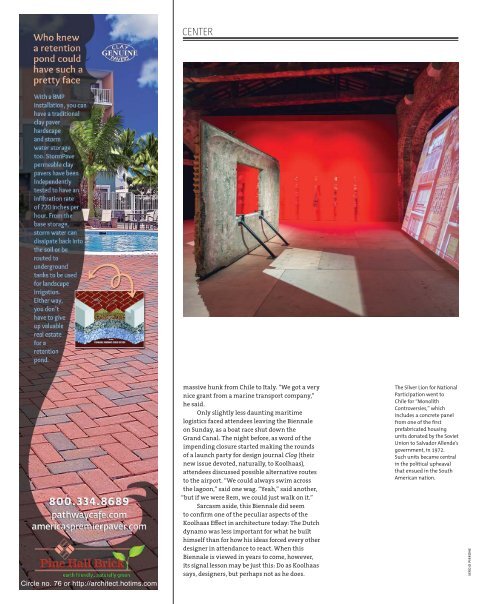Architect 2014-07.pdf
Create successful ePaper yourself
Turn your PDF publications into a flip-book with our unique Google optimized e-Paper software.
CENTER<br />
Circle no. 76 or http://architect.hotims.com<br />
massive hunk from Chile to Italy. “We got a very<br />
nice grant from a marine transport company,”<br />
he said.<br />
Only slightly less daunting maritime<br />
logistics faced attendees leaving the Biennale<br />
on Sunday, as a boat race shut down the<br />
Grand Canal. The night before, as word of the<br />
impending closure started making the rounds<br />
of a launch party for design journal Clog (their<br />
new issue devoted, naturally, to Koolhaas),<br />
attendees discussed possible alternative routes<br />
to the airport. “We could always swim across<br />
the lagoon,” said one wag. “Yeah,” said another,<br />
“but if we were Rem, we could just walk on it.”<br />
Sarcasm aside, this Biennale did seem<br />
to confirm one of the peculiar aspects of the<br />
Koolhaas Effect in architecture today: The Dutch<br />
dynamo was less important for what he built<br />
himself than for how his ideas forced every other<br />
designer in attendance to react. When this<br />
Biennale is viewed in years to come, however,<br />
its signal lesson may be just this: Do as Koolhaas<br />
says, designers, but perhaps not as he does.<br />
The Silver Lion for National<br />
Participation went to<br />
Chile for “Monolith<br />
Controversies,” which<br />
includes a concrete panel<br />
from one of the first<br />
prefabricated housing<br />
units donated by the Soviet<br />
Union to Salvador Allende’s<br />
government, in 1972.<br />
Such units became central<br />
in the political upheaval<br />
that ensued in the South<br />
American nation.<br />
SERGIO PIRRONE


















